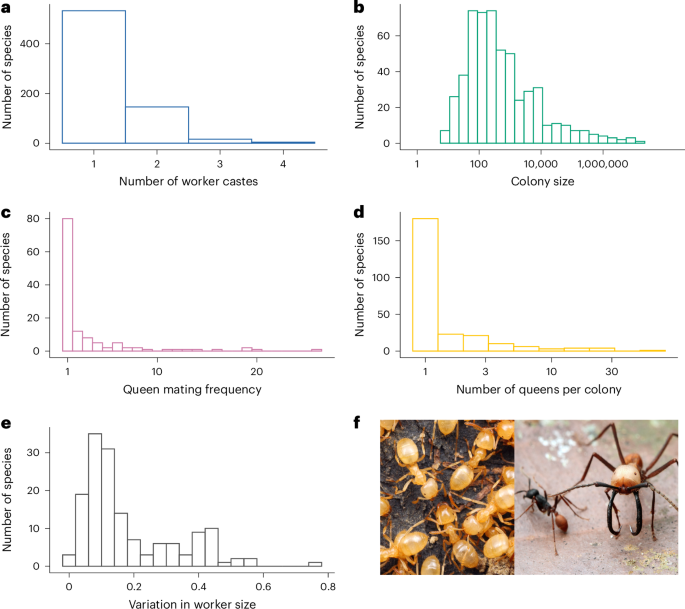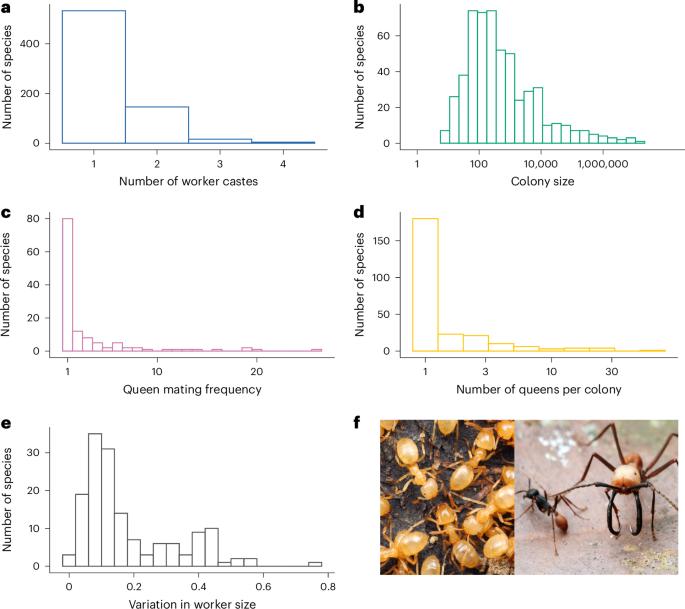Larger colony sizes favoured the evolution of more worker castes in ants
IF 13.9
1区 生物学
Q1 ECOLOGY
引用次数: 0
Abstract
The size–complexity hypothesis is a leading explanation for the evolution of complex life on earth. It predicts that in lineages that have undergone a major transition in organismality, larger numbers of lower-level subunits select for increased division of labour. Current data from multicellular organisms and social insects support a positive correlation between the number of cells and number of cell types and between colony size and the number of castes. However, the implication of these results is unclear, because colony size and number of cells are correlated with other variables which may also influence selection for division of labour, and causality could be in either direction. Here, to resolve this problem, we tested multiple causal hypotheses using data from 794 ant species. We found that larger colony sizes favoured the evolution of increased division of labour, resulting in more worker castes and greater variation in worker size. By contrast, our results did not provide consistent support for alternative hypotheses regarding either queen mating frequency or number of queens per colony explaining variation in division of labour. Overall, our results provide strong support for the size–complexity hypothesis. Using data from 794 ant species, the authors test alternative causal models to explain the evolution of complexity in ant colonies. They find evidence that larger colony sizes favoured the evolution of greater division of labour, providing support for the size–complexity hypothesis.


较大的蚁群规模有利于蚂蚁进化出更多的工蚁种姓。
规模-复杂性假说是地球上复杂生命进化的主要解释。根据该假说的预测,在经历了有机体重大转变的类群中,较低级别的亚单位数量越多,分工就越多。目前来自多细胞生物和社会性昆虫的数据支持细胞数量与细胞类型数量之间以及群落规模与种姓数量之间的正相关关系。然而,这些结果的含义并不清楚,因为群体大小和细胞数量与其他变量相关,而这些变量也可能影响分工选择,因此因果关系可能是双向的。为了解决这个问题,我们利用来自 794 个蚂蚁物种的数据测试了多种因果假设。我们发现,较大的蚁群规模有利于分工的进化,从而产生更多的工蚁种群和更大的工蚁体型差异。相比之下,我们的结果并不支持关于蚁后交配频率或每个蚁群蚁后数量可解释分工变化的其他假设。总之,我们的结果有力地支持了体型复杂性假说。
本文章由计算机程序翻译,如有差异,请以英文原文为准。
求助全文
约1分钟内获得全文
求助全文
来源期刊

Nature ecology & evolution
Agricultural and Biological Sciences-Ecology, Evolution, Behavior and Systematics
CiteScore
22.20
自引率
2.40%
发文量
282
期刊介绍:
Nature Ecology & Evolution is interested in the full spectrum of ecological and evolutionary biology, encompassing approaches at the molecular, organismal, population, community and ecosystem levels, as well as relevant parts of the social sciences. Nature Ecology & Evolution provides a place where all researchers and policymakers interested in all aspects of life's diversity can come together to learn about the most accomplished and significant advances in the field and to discuss topical issues. An online-only monthly journal, our broad scope ensures that the research published reaches the widest possible audience of scientists.
 求助内容:
求助内容: 应助结果提醒方式:
应助结果提醒方式:


